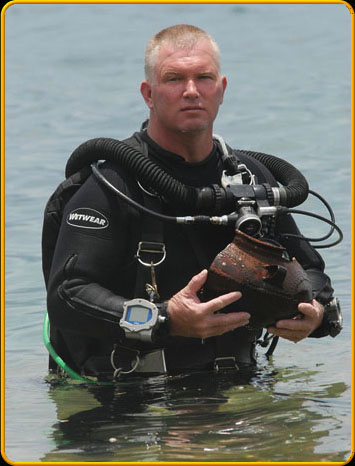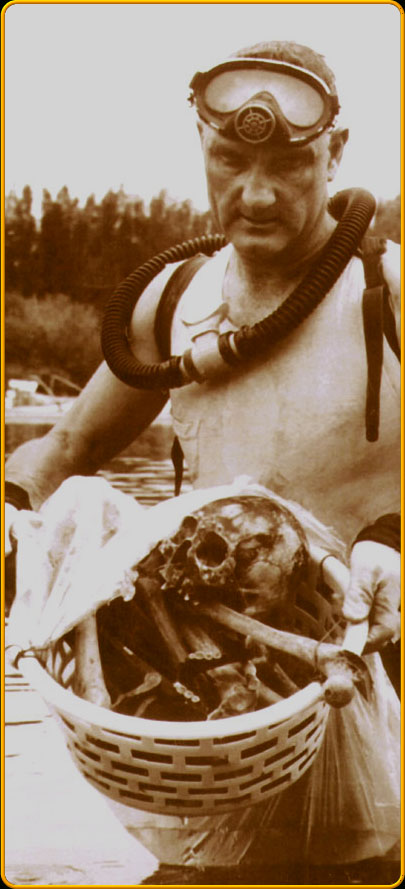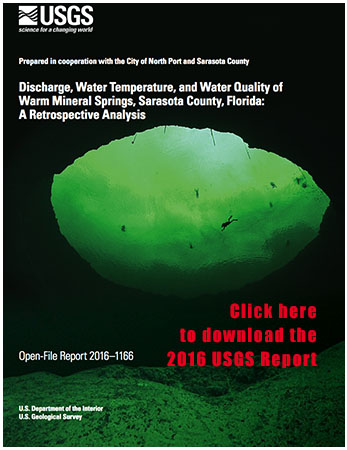 |
| |
|
| |
|
| |

|
|
|
| Join modern day explorer, Curt Bowen as he takes you on a journey and shows you the Mysteries of Warm Mineral Springs – Revealed. 10:45min
|
|
|
|
 |
Ten thousand years ago giant ice sheets covered most of North America. At that time, Florida had a climate more like North Carolina, unlike the subtropical climate it has today. The vegetation consisted of large grassy plains and thick forests of oak and hickory trees. A variety of animals including Wooly Elephants, Giant Ground Sloths, North American Camels, Saber-Toothed Cats, and many other species, roamed throughout Florida.
It is believed that water sources in the Warm Mineral Springs area were few and far between due to the porous limestone rock layers below the surface, which kept most of the water movement underground. At that time, oceans were 70 to 90 feet shallower due to the large amounts of water trapped in the giant sheets of ice. This theory can be proven by studying the flowstone formations found in Warm Mineral Springs, which are believed to have opened to the surface as early as thirty thousand years ago. Hundreds of flowstones were formed around the sink's upper lip at 20 feet with a few formations located as deep as 70 feet. Because flowstones can only form in a dry chamber over thousands of years, these patterns indicate that the oceans must have been considerably lower than they are today. The western coast of Florida extended miles to the west and south, doubling Florida's present size.
Today, Warm Mineral Springs is considered a health spa, visited by thousands of people seeking the warm soothing mineral waters believed to be helpful in healing many ailments. Fifty years ago, William Royal, the first diver to ever venture below the surface, discovered extinct animal bones, stalactite formations, and human remains. The archaeological world initially dismissed his findings as a farce because, according to fossil records, it was believed that man arrived in Florida no earlier than seven thousand years ago. For the last forty years, several archaeological projects have been conducted in and around Warm Mineral Springs resulting in many outstanding discoveries. The most astonishing was the discovery of a ten thousand year old human skull still containing brain matter.
The human remains discovered in Warm Mineral Springs were carbon dated back to ten thousand years ago. This finding changed the theory about the time of Homosapien movement across North America to four thousand years earlier than previously believed. These early American Indians hunted, scavenged, and followed along the banks of rivers, lakes, streams, and springs across America. These Indians finally made it to the Florida peninsula and eventually encountered the unique site of Warm Mineral Springs.
When the Indians arrived, Warm Mineral Springs was a giant pit surrounded by a huge forest. This giant pit dropped quickly from the surrounding forest vegetation. Water trickled down the walls and into the pit below. This is revealed today by the water channels sculpted into the walls at depths from 40 to 55 feet. At 32 feet, the walls undercut themselves making a natural shelter from the outside elements. These early Paleo Indians must have considered Warm Mineral Springs a sacred place because they buried their dead along the walls at 35 feet. Human remains and primitive tools dating from three to ten thousand years old have been excavated from the sink and the surrounding lands over the last forty years.
Geologically, Warm Mineral Springs is a solution hole descending into one of the deepest Florida aquifers. The water flowing from this spring is anaerobic (low in oxygen) and is believed to have been trapped underground for over thirty thousand years at depths exceeding 7000 feet. Under these great pressures, the water is geothermally heated to 97º degrees Fahrenheit and flows from several small caves located on the northern wall at depths from 195 to 210 feet. As the water rises towards the surface, it mixes with cooler water from colder vents. When it reaches the surface, the temperature drops to 85º degrees Fahrenheit. Eight million gallons of water a day flow down a natural run on the surface and eventually into the Gulf of Mexico.
|
|
|
 |
|
| Above Image: Adventurer and amateur archeologist Col Bill Royal turned the academic world of archeology on its ear in the 1970s. After nearly 25 years of denial, ridicule and general disrespect to Col Royal, in the 1970s the evidence amassed proved that Royals claims that the Paleo-Indian burials he had discovered in the 1950s were indeed over 10,000 years old.Royal's discovery led to extensive excavations and academic research at the site, much of which served to repetitively prove the accuracy of his own research and to establish the site as one of the most important archeological sites in North America. |
|
|
|
|
|
|
| |
Warm Mineral Springs at 145 feet looking up.
Once a decade Warm Mineral Springs clears to almost gin clear water.
This unique phenomenon only occurs when the North Port area receives torrential rain for many days in a row. Heavy flooding increases the upper hydrostatic pressure on the spring, pumping in millions of gallons of clear cooler water.
Normally, Warm Mineral Springs water clarity is an average of 8 to 10 feet.
On July 28th, 2015 North Port received over 15 inches of rain during a week period, clearing Warm Mineral from the top to the bottom.
This image was captured at a depth of 145 feet off to the south side of the debris cone. Looking up through the green tinted water, a diver swims across the sink at a depth of 60 feet, while bathers float on the surface.
Photo by Curt Bowen |
|
|
|
| |
 |
Discharge, Water Temperature, and Water Quality of Warm Mineral Springs, Sarasota County, Florida: A Retrospective Analysis |
By Patty A. Metz |
U.S. Department of the Interior
U.S. Geological Survey |
| |
Purpose and Scope
The purpose and scope of this report is to provide a summary of retrospective studies (available from published reports and databases) pertaining to the geologic and hydrologic setting of the region, and the water temperature, discharge, and water chemistry of Warm Mineral Springs. The study area includes Warm Mineral Springs and the Myakka River Basin (fig. 1A). Data were compiled from published sources from various agencies including the Florida Geological Survey, Sarasota County, Southwest Florida Water Management District (SWFWMD), and the U.S. Geological Survey (USGS). Data from the SWFWMD Regional Observation Monitor-Well Program (ROMP), and other wells, were used to assess regional groundwater levels.
The USGS in cooperation with the City of North Port and Sarasota County, Florida, conducted a study to review, summarize, and analyze existing data pertaining to Warm Mineral Springs. The retrospective summary addresses (1) the regional hydrologic and geologic setting, (2) anthropogenic effects such as water use, (3) sources of warm water, (4) discharge and water temperature, and (5) geochemistry and water quality. The associated analyses are intended to provide information to local, regional, and State water-resource professionals to better understand and sustainably manage Warm Mineral Springs. |
| Click left image to download entire report. |
|
|
|
| |
 |
This site is operated, designed, and financed 100% by the ADM Exploration Foundation and Curt Bowen. Donations to help cover annual expenses are encouraged.
Respectfully
Curt Bowen |
|
| All images and Illustration © Curt Bowen -2010 www.curtbowen.com |
|